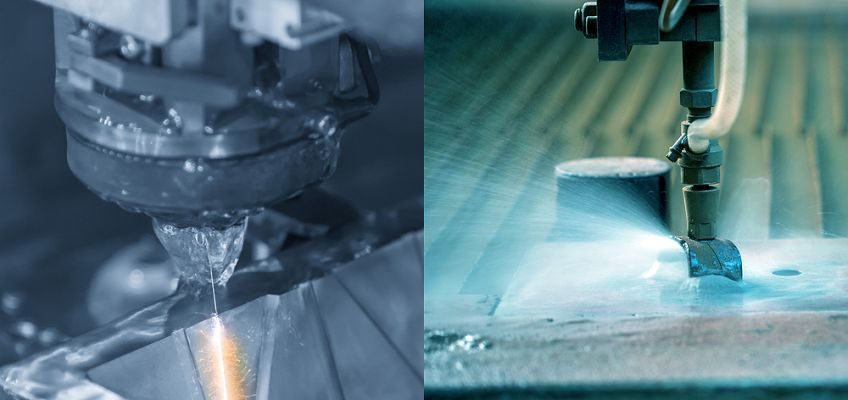When deciding on a cutting method, the tolerance level determines how much precision you can apply for cutting and shaping work materials.
There are a variety of different cutting technologies that can help you in the process. We recently looked at Wire EDM vs Laser Cutters.
In this post, we’re going to compare Wire EDM and Water Jet Cutting. Although the techniques may seem to be similar, several differences give EDM cutting an edge over water jet cutting.
EDM Cutting
Wire EDM cutting is a process that can cut and shape tough materials like titanium and steel. The key is that the workpiece must be electrically conductive.
Then an electrode creates a spark which produces intense heat. Temperatures can enter the range of 8,000 to 12,000 degrees Celsius, easily melting just about anything. This spark is very carefully controlled so that the material can be shaped as water carries away the eroded particles and acts as a coolant. This way the spark only affects the chosen surface of the given material.
One of the major benefits of EDM cutting is the highly accurate precision. Wire EDM is about 10 times more accurate than waterjet cutting.
Waterjet Cutting
Waterjet technology is a technique used to shape a variety of materials from foam to ceramics to titanium. Using this method, a waterjet is used to produce a very high pressure of steam to make a narrow line in the given material. Depending on the stiffness of the material, a granular abrasive can be added to the waterjet. This helps to increase the cutting power.
You can think of waterjet cutting as a faster EDM machine with less precision. The primary advantage of waterjet cutting is the speed, making cuts 10 times faster than EDM. Waterjet cutting is also not limited to cutting conductive materials.
Contrary to Wire EDM, a drawback to waterjet cutting is it’s difficulty with thin materials. The pressure can be too high and cause vibration of thin parts. This means each piece has to be but separately with pressures reduced, thus creating less accuracy.
And lesser precision is the primary reason why waterjet cutting falls short of EDM cutting technology, whether due to thin pieces or not.
Waterjet cutting has come a long way because it is possible to improve water jet precision by increasing the pressure of the waterjet, or by adding a granular abrasive, or by using a nozzle to make the cutting process more flexible. But even with all that, when it comes to precision cutting control, EDM leads the way.
Which Cutting Technology to Choose?
Both the technologies have evolved over the years, and it is time to decide which technique will be best suited for your project. Before going into the details, one thing that you should know is that EDM is further divided into two techniques depending on the surface and the accuracy of the finish that you need. The two techniques are one cut and skim cut.
One cut, which is kind of apparent from the name, uses a single wire system. The wire passes through the solid part. When the cutting action is complete, a piece of scrap drops away. Although this provides sufficient accuracy for some jobs, skim cutting is often used to finish the job as it has a greater level of precision.
Skim cut is a technique where the wire of the EDM passes back over the rough surface but with a lower power setting and also a low-pressure flush. In most of the cases, two skims are used to do the job, but if the surface is very rough, then as many as nine skims can be used. A single skim pass can remove as little as 0.0001 inches of material or as much as 0.002 inches.
In summary, if you need to work within a small area and need highly accurate precision, then Wire EDM is your wise choice. On the other hand, if you have a wider surface where precision is not the main focus, but speed is, then water jet cutting can be applied.
However, keep in mind the issue of cutting thin materials with a waterjet. Whereas the process has to be slowed down for water jet cutting, with Wire EDM, thin materials can be stacked and cut simultaneously. For example, with WEDM the most ideal cutting thickness is 2” thick. If you have 0.01” thick pieces, wire EDM can cut 200 simultaneously. Suddenly EDM is much faster than water jet cutting.
As in this example, you should be aware that there are many different techniques we can utilize with Wire EDM. Therefore, assuming you have conductive material, you might want to try this method first.
Of course, you might think we have a biased opinion, so we would be happy to show you our capabilities. You will be pleased to discover what we can offer for your project. Depending on size, application, and tolerance, WEDM could be a more affordable and more precise option.

